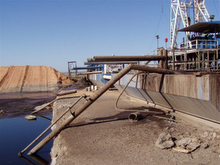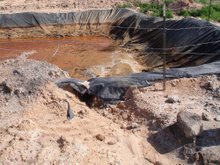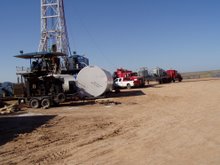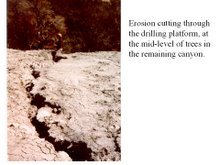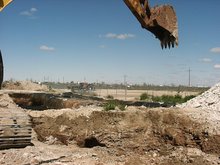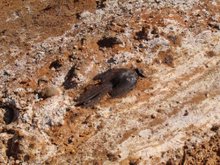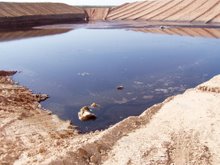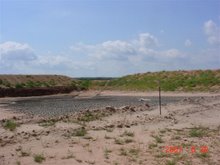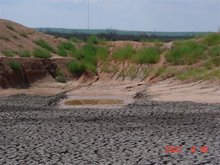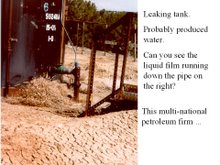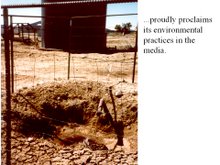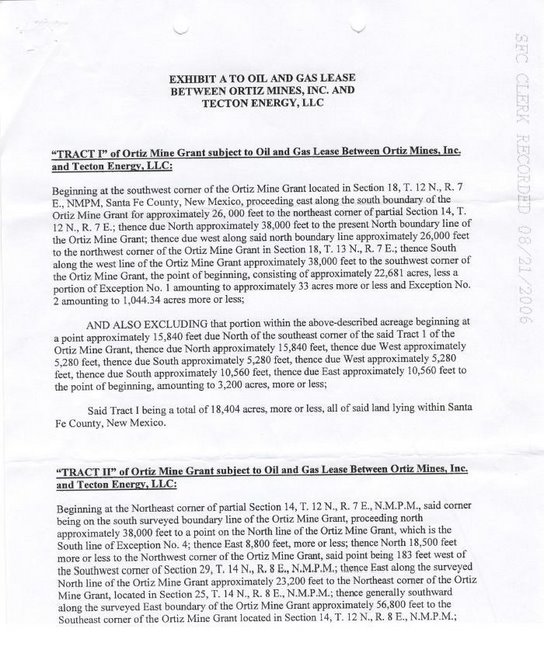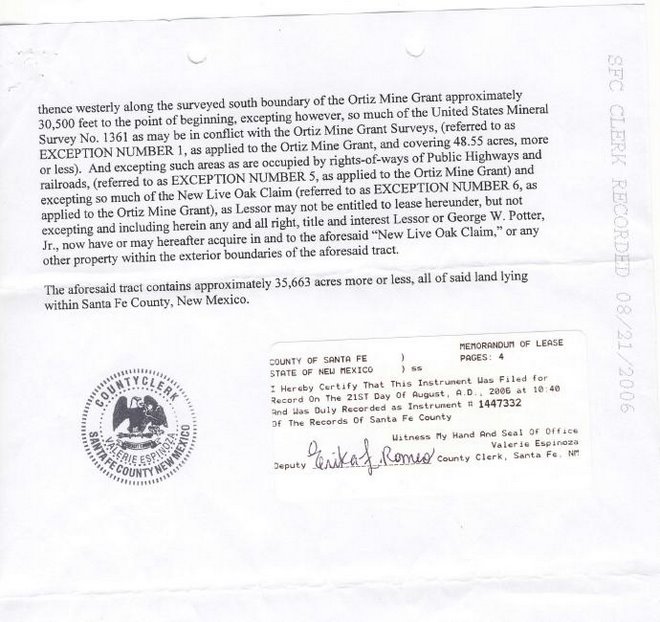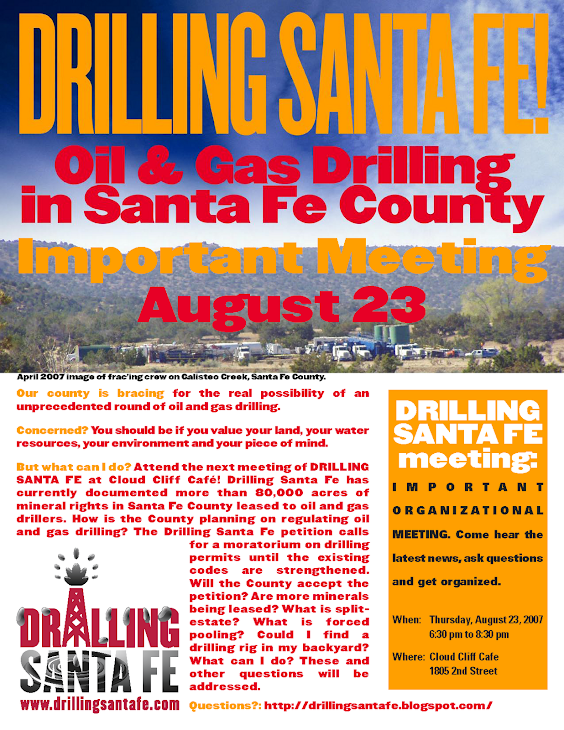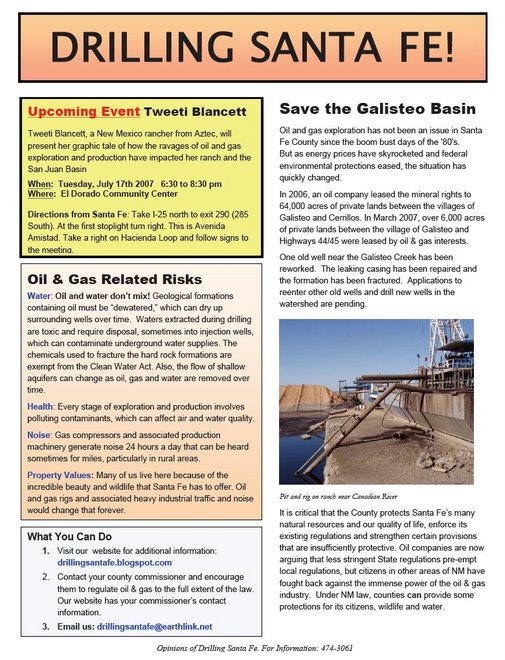(Click images for larger views.)
In April, residents along the Galisteo Creek were alarmed and puzzled by the clouds of dust rising from the long lines of Schlumberger trucks winding down their road. But most of the activity down at the old oil well was cloaked in vague euphemisms, and guards kept the curious neighbors far away from the activity of the crews fracturing the formation under the well. The large amounts of hydrochloric acid poured into that well in the ‘80’s probably corroded the casing and chemical reactions hampered the flow of oil. Now they have the old, leaky casing repaired, and after new rounds of chemicals and thousands of barrels of water pumped into the formation, they hope to have the high quality oil flowing again. The exploration company is eager to drill more wells. They have secured mineral leases stretching from southeast of Galisteo, through the entire Ortiz Mining Grant, and then to sections north of the San Marcos Pueblo Grant.
Yes, they did find oil and gas back in the ‘80s. Three large production units covering hundreds of square miles were proposed. These units stretched from ten miles north of Agua Fria, back down the Sandoval County line, and included most of the San Marcos and Galisteo communities. But the boom turned to bust when prices plummeted. They ran into problems perforating and acidizing the hard rock formations in the exploratory areas south and west of Santa Fe. There was no pipeline to transport the natural gas. Now there is a proposed gas pipeline that would follow the Lamy railroad tracks back to the main pipeline along I-25. They plan to transport the oil in caravans of tanker trucks to refineries west of Albuquerque.
In the ‘80s exploration companies drilled several wells along Galisteo Creek and one near Bonanza Creek. Another well was drilled northeast of the San Marcos Pueblo Grant. They also drilled northwest of the village of Agua Fria, and a well was drilled near Goldmine Road. A geologist has written about the cores of those wells and theorized that the Santa Fe Embayment, as it has been called, could be as lucrative as the San Juan Basin, which now provides billions of dollars in revenue for the oil companies from thousands of wells drilled in northwestern New Mexico and southern Colorado. However, some are skeptical. According to studies published (Albuquerque-Santa Fe Rift)( Bruce Black) over the last twenty five years, Santa Fe County contains at least three geological formations with millions of barrels of high grade oil. These experts also estimate that other formations could contain trillions of cubic feet of natural gas. Unfortunately, petroleum is found in the ancient basins that provide our limited water resources and hold the fragile habitat for wildlife and the remains of ancient civilizations.
Landowners south and southwest of Santa Fe are now learning that the mineral leases under their property take legal precedent over their surface rights. If the State or Federal governments own the minerals, some internet research (Go-Tech) will probably tell you what oil exploration company might be contacting you. However, if your minerals are privately owned and passed down through generations, it is a difficult project to discover who now controls those mineral rights. The exploration company that secures the mineral rights under your land still must negotiate and pay you some damages. But ultimately, the drillers can invade your property and bulldoze a large site, set up a waste pit (Waste Pit )( Oil & Gas Waste Disposal) , and begin to extract the minerals that they have leased.
New Mexico finally has a Surface Owners Protection Act that became law on July 1. But that act needs to be strengthened. It offers no protections for the neighbors and the community. This law still allows the rights of the mineral estate to take precedent over your rights as the owner of the surface. If you live within a few miles of oil and gas production as it is now carried out in New Mexico, the noise, the air pollution, and the potential water contamination will impact the value of your property and your way of life. Unfortunately, your neighbors may negotiate agreements to keep the noise and pollution away from their water wells and homes, but you might have the drilling rig and subsequent production facilities near your home and water well. Too many water wells in New Mexico have already been contaminated by oil and gas exploration and production. Landowners in Colorado have made some progress. On May 30, 2007, the Governor signed a new Surface Rights Act that brings surface rights in Colorado closer to equal status with mineral leases.
There is an opportunity now to urge Santa Fe County to strengthen their regulations to prevent some of the damage and health hazards that this level of oil and gas exploration and production has inflicted on our neighbors in northwestern and southeastern New Mexico. Ultimately, the state government must enact the environmental protections afforded residents of other states. Oil and gas resources can be exploited without the damage now allowed.
The Oil Conservation Division, our state agency charged with maximizing and regulating oil and gas production, has recently attempted to control the dumping of hazardous waste and is now attempting to write new regulations to minimize toxic pit pollution. Industry is pushing back. The New Mexico Oil and Gas Association sued the state over attempts to control the dumping of hazardous waste and is now fighting hard to weaken proposed regulations to control the pollution from toxic pits. New Mexico is at a crossroads. Santa Fe County officials need to hear from well-informed citizens, and we can be a part of that process that finally demands the strictest environmental protections.
* Where will the millions of gallons of water come from that are
turned to waste with every well drilled.
* Is Santa Fe County prepared for the constant fire danger from
flaring the toxic gases produced by oil wells and transporting flammable hydrocarbons?
*Will there be zoning to keep the constant noise and hazards of drilling
and production far away from water wells, homes, and aquifers?
*Will neighbors be notified of applications for drilling permits in their area?
*Will the many miles of roads that accompany this possible scale of drilling be
built correctly and maintained properly?
*Will drilling under or through our aquifers or near our water wells be absolutely prohibited?
There are several organizations working to educate the public and assist local governments grappling with the explosive growth in oil and gas exploration in New Mexico. Learn more about the threats to your air and water, your quiet nights, and peaceful country roads. Learn how to negotiate protections for the surface of your land. Here is a good place to start: (Oil and Gas Accountability Project).
Contact your county commissioner (Santa Fe County Commissioners). The link also has the district map. Ask your commissioner to regulate oil and gas to the fullest extent of the law and to demand that the county conduct a governmental hydrogeological study before considering issuing drilling permits.
Disclaimer: The views expressed are those of Drilling Santa Fe.
Want to know more about the history of oil and gas exploration in Santa Fe County?
Want to hear more about the exploration plans for Santa Fe County?
Want to learn about surface owner rights?
Would you like to be added to an email list?
Would you like to join Drilling Santa Fe?
Then, email: drillingsantafe@earthlink.net
For OCD - Well Reports:
Click here for EMNRD direct access. Then click "Well Files." Then go to "County" and select from the drop down menu "Santa Fe." Then click "Continue." Done.
Link to the OCD site is on the Drilling Santa Fe website under Educational Links.
Thursday, June 28, 2007
Oil and Gas Exploration in Santa Fe County
Subscribe to:
Comments (Atom)



